THE DOLOMITES: NATURAL HERITAGE OR BUILDING SITE?
Sonia Sbolzani

The year 2011 has been declared the International Year of Forests by the UN. It therefore comes as a double blow to hear that there is a plan in the pipeline to cut down thousands of trees right in the heart of the Dolomites, in order to make room for new ski lifts, building programmes, and associated businesses. The Dolomites are widely considered the world's most beautiful mountains and a prime example of sustainable development: indeed, they have been declared a Natural Heritage site by Unesco. In recent weeks, even the national newspapers have been full of information and comments on the bitter battle being raged between environmentalists and public bodies in Alto Adige: in the names of protecting nature and promoting tourism respectively.
Michil Costa, the well-known hotelier and restaurateur from Corvara, has always been in the front line of defence for this area. We interviewed him to hear his point of view regarding the situation.
Mr. Costa, do you think that at a national level we are ignoring the alarm sounding from the Dolomites?
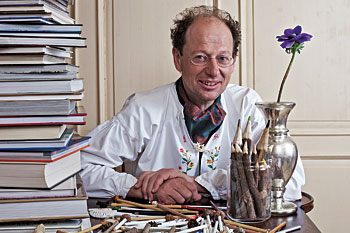 I think the alarm should be sounding more for us than for the Dolomites. We only seem to want new, impressive installations. "Cubature": that's the magic word. We forget the example of beautiful design provided by the oldest settlements. I'm thinking of those lovely, typical Ladin houses, of the mushroom-shaped houses in Val Badia and their 500-year-old barns: real examples of practical, traditional design. But what I'm really afraid of is the "senfterization" of South Tyrol (Senfter is the famous smoked ham producer, and financed the new ski carousel at Sesto). We are in danger of losing our history and turning into a parody of ourselves. Do you know the big casinos in Las Vegas? Well, there we are. We are at risk of becoming like "The Venice", the casino famous for being a copy of Venice. But it makes sense there; creating a little Venice in the middle of the desert. But here we have a real existence, with real history and traditions; we can't just become a tourist parody of ourselves! We have gone into decline. How much ugliness there is and how much insensitivity! How much light and noise pollution! The Dolomites shouldn't be on airline routes either: the white exhaust trails from the planes reduce the power of the sun-light. We are producing a sort of porno-Alpine tourism, with monstrous hotels on the one hand, and frightening kitsch design on the other. We just go on building in South Tyrol, not because there are sane reasons for developing, but in order to pay less tax and obtain grants. There should be subsidies for good ideas, not cubic metres of cement. I think the alarm should be sounding more for us than for the Dolomites. We only seem to want new, impressive installations. "Cubature": that's the magic word. We forget the example of beautiful design provided by the oldest settlements. I'm thinking of those lovely, typical Ladin houses, of the mushroom-shaped houses in Val Badia and their 500-year-old barns: real examples of practical, traditional design. But what I'm really afraid of is the "senfterization" of South Tyrol (Senfter is the famous smoked ham producer, and financed the new ski carousel at Sesto). We are in danger of losing our history and turning into a parody of ourselves. Do you know the big casinos in Las Vegas? Well, there we are. We are at risk of becoming like "The Venice", the casino famous for being a copy of Venice. But it makes sense there; creating a little Venice in the middle of the desert. But here we have a real existence, with real history and traditions; we can't just become a tourist parody of ourselves! We have gone into decline. How much ugliness there is and how much insensitivity! How much light and noise pollution! The Dolomites shouldn't be on airline routes either: the white exhaust trails from the planes reduce the power of the sun-light. We are producing a sort of porno-Alpine tourism, with monstrous hotels on the one hand, and frightening kitsch design on the other. We just go on building in South Tyrol, not because there are sane reasons for developing, but in order to pay less tax and obtain grants. There should be subsidies for good ideas, not cubic metres of cement.
You fought hard against the building of a road through the forest at Antersasc, and you coined the phrase "the Antersasc method" to describe the strategy of laying concrete. Which parts of the Dolomites are most at risk here, do you think?
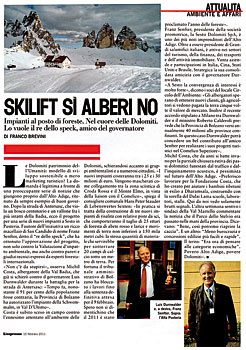 The areas with the highest number of tourists, for sure. When the ratio of visitors to residents is totally out of balance, the important social and cultural structures start to disappear. Children grow up with values very different to those of their origins. It is only by recognizing the authenticity of these places, and of our culture and language, that we will manage to discover and perpetuate a proper balance with our surroundings. However, even the most unspoilt areas are in danger. These places may plunge in with even more passion during the "cubature" process, or else they will experience a period of de-ruralisation: the villages in the valley bottom will grow in size, the marginal land will be abandoned, the traditional activities will cease, and life-styles will become standardized. The areas with the highest number of tourists, for sure. When the ratio of visitors to residents is totally out of balance, the important social and cultural structures start to disappear. Children grow up with values very different to those of their origins. It is only by recognizing the authenticity of these places, and of our culture and language, that we will manage to discover and perpetuate a proper balance with our surroundings. However, even the most unspoilt areas are in danger. These places may plunge in with even more passion during the "cubature" process, or else they will experience a period of de-ruralisation: the villages in the valley bottom will grow in size, the marginal land will be abandoned, the traditional activities will cease, and life-styles will become standardized.
That being said, however, I should add that tourism has brought prosperity to me, to my family, and to many other worthy hoteliers here in Badia and all over South Tyrol. I work hard to ensure that this prosperity continues and I don't want to be seen as a conservationist prig. I believe I have a modern approach to development, and I think that seeing development simply in terms of laying concrete is a notion left over from the 1950s. I am sure it does no good to our economy either. When the tourists find themselves in a South Tyrol all under concrete, will they still love it? The creation of a tourist monoculture is enormously damaging.
One of your latest hobby-horses has been the dismantling of Stelvio Park, whose management is being handed by the Government to the care of the Lombardy, Trento and Bolzano authorities. What risks do you envisage for this 135-hectare Park?
It's what I call "developism". Let me define this for you: "developism" is whatever generates the largest amount of money in the shortest possible time. The main limitation to "developism" is its total absence of any type of planning. It lacks any sort of vision of the future. We open the hunting season, give out concessions, and then do everything that brings in money: at once. I always cite the Valfurva as an example of "developism", and the destruction carried out in that area at the time of the World Ski Championships in 2005. This even led to sanctions by the EU.
You subsequently raised an outcry against the latest project to build ski-lifts in Alta Pusteria. How will this affect the environment?
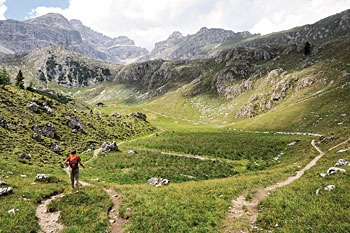 The new ski-lifts will cost between 25 and 30 million Euros, and will involve cutting down 25 hectares of spruce pine and larch forest. I ask myself nowadays if we live in the South Tyrol of the Dolomites or of the ski-lifts. I really wonder whether people come here to enjoy the landscape, or to see the girders, cables and cableways, and the huge canary-yellow pipes in among the crocuses. The company promoting this project is the Sesto Dolomites organization, headed by Franz Sentfer, one of the best-known businessmen in Alto Adige. By means of this operation, the hoteliers hope to get more customers, and the farmers will be paid five times the going market price for their land. To see the farmer uprooted from his land for money: this makes me very unhappy. It is an attack on our land, on our basic culture, because the farmer is a vital player in the South Tyrol local order. It is no accident that one of the most important figures in our culture is the "Saltner" (vineyard- keeper), protector of the land and those who work it. What will we be able to offer our guests in the future? Frozen vegetables and packaged ham? We haven't mentioned the recent agreement drawn up in Milan between Luis Durnwalder, President of the Autonomous Province of Bolzano, and Minister Calderoli, which obliges the Province of Bolzano to pay 40 million Euros a year to its neighbouring provinces. As a result of this, Mr. Durnwalder will be able to make a nice contribution to his friend Mr. Senfter, enabling him to carry out his tourist projects in the Upper Comelico region. The new ski-lifts will cost between 25 and 30 million Euros, and will involve cutting down 25 hectares of spruce pine and larch forest. I ask myself nowadays if we live in the South Tyrol of the Dolomites or of the ski-lifts. I really wonder whether people come here to enjoy the landscape, or to see the girders, cables and cableways, and the huge canary-yellow pipes in among the crocuses. The company promoting this project is the Sesto Dolomites organization, headed by Franz Sentfer, one of the best-known businessmen in Alto Adige. By means of this operation, the hoteliers hope to get more customers, and the farmers will be paid five times the going market price for their land. To see the farmer uprooted from his land for money: this makes me very unhappy. It is an attack on our land, on our basic culture, because the farmer is a vital player in the South Tyrol local order. It is no accident that one of the most important figures in our culture is the "Saltner" (vineyard- keeper), protector of the land and those who work it. What will we be able to offer our guests in the future? Frozen vegetables and packaged ham? We haven't mentioned the recent agreement drawn up in Milan between Luis Durnwalder, President of the Autonomous Province of Bolzano, and Minister Calderoli, which obliges the Province of Bolzano to pay 40 million Euros a year to its neighbouring provinces. As a result of this, Mr. Durnwalder will be able to make a nice contribution to his friend Mr. Senfter, enabling him to carry out his tourist projects in the Upper Comelico region.
You have been demanding for some time that the passes through the Dolomites should be closed during the summer, at least partially, to avoid pollution. Why is it so difficult to reach a decision about this?
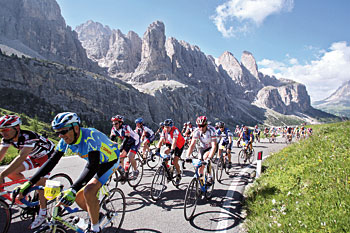 Oh I don't know! Perhaps we should go and look around Switzerland a bit! This isn't the first time I've cited Switzerland as an example, but it's our neighbour, and they also speak Ladino in some parts, which makes me feel well disposed towards them. They really discourage the use of cars: in fact there are some villages and areas you can't even get to by car - I'm thinking of delightful places like Mürren or Saas Fee. Consider how easy it is for tourists to travel by train or public transport. But to get back to us: although I have every respect for motorcyclists, I'd prefer us to be regarded as a paradise for cyclists, rather than for motorcyclists. Ask the Alpine guides why they don't go climbing on the Sella towers any more: they can't make themselves understood with their clients because of the noise from the motordrome a few hundred metres below. We can provide a splendid example with the Dolomites Marathon, involving the participation of 9,000 cyclists out of 28,000 requests for entry! Let's make the roads over our passes a paradise for cyclists and everyone will benefit: both the managers of the refuge huts and the environment! Oh I don't know! Perhaps we should go and look around Switzerland a bit! This isn't the first time I've cited Switzerland as an example, but it's our neighbour, and they also speak Ladino in some parts, which makes me feel well disposed towards them. They really discourage the use of cars: in fact there are some villages and areas you can't even get to by car - I'm thinking of delightful places like Mürren or Saas Fee. Consider how easy it is for tourists to travel by train or public transport. But to get back to us: although I have every respect for motorcyclists, I'd prefer us to be regarded as a paradise for cyclists, rather than for motorcyclists. Ask the Alpine guides why they don't go climbing on the Sella towers any more: they can't make themselves understood with their clients because of the noise from the motordrome a few hundred metres below. We can provide a splendid example with the Dolomites Marathon, involving the participation of 9,000 cyclists out of 28,000 requests for entry! Let's make the roads over our passes a paradise for cyclists and everyone will benefit: both the managers of the refuge huts and the environment!
I would like people reading this to come to Corvara. We have a fine road packed with cars which drive through the middle of the village at 80 kph. Until last summer, it was a pedestrian zone at certain times of day. The mayor has now removed this provision. Mothers will be happy when forced to take their babies up the "vie ferrate" (mountain paths), because it's no longer possible to walk through the village!
You are constantly emphasizing the ideas of "creating a culture", "educating people about the Alps", "teaching an aesthetic perspective". How can you translate these concepts into real action?
Without trying to be modest, I want to say something about "educating people about the Alps". A lot of this education process is done by us, the hotel-owners. Here in Alta Badia, and in many other parts of the South Tyrol, the hoteliers have some excellent partners they're working with: I'm talking about the Alpine guides, the specialized personnel who take tourists on excursions of varying difficulty. Yes, these people are the most effective teachers. They love nature and they communicate their respect and enthusiasm for the places they visit. You have to start in the schools. You have to talk about the wonder of silence, and of listening to the world around you, as vital elements you can experience in your free time and then take back into your everyday life. I have been talking for years about creating a department of aesthetics.
 Again on the theme of culture, I do not agree with the reasoning used by Messner to justify the new constructions. He uses a historical and cultural premise as a logical basis for his argument. It amounts to this: those areas and high plateaus where we have proof that man once lived, and in general those places that might have been inhabited in the past (up to the rock line, in practice), can justifiably be inhabited by man today, because this is just a continuation of a historic tradition. But we are forgetting to mention one thing: man's impact on the environment was infinitely less great in the past. In mediaeval times, or even in the 1800s, the people who inhabited this area did not live in concrete structures, with spas and golf courses. Maybe we'll be discovering next that Otzi the Ice Man played golf and drove a Cayenne… Again on the theme of culture, I do not agree with the reasoning used by Messner to justify the new constructions. He uses a historical and cultural premise as a logical basis for his argument. It amounts to this: those areas and high plateaus where we have proof that man once lived, and in general those places that might have been inhabited in the past (up to the rock line, in practice), can justifiably be inhabited by man today, because this is just a continuation of a historic tradition. But we are forgetting to mention one thing: man's impact on the environment was infinitely less great in the past. In mediaeval times, or even in the 1800s, the people who inhabited this area did not live in concrete structures, with spas and golf courses. Maybe we'll be discovering next that Otzi the Ice Man played golf and drove a Cayenne…
If, by some chance, you woke up tomorrow and found yourself in the shoes of the President of Bolzano's Provincial Government, what would be your first plan of action?
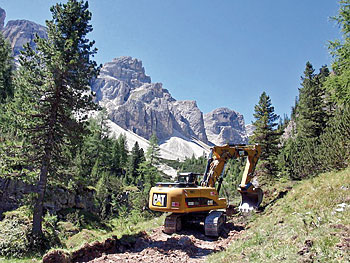 I am not openly hostile towards Durnwalder, and I recognize his good qualities. That being said, in all the European democracies, there are no periods of tenure which last as long as that of Landeshauptmann (Head of Government). Maybe in Italy there are cycles which last for twenty years, but this is not the case in Germany, Austria, Britain, France and the Scandinavian countries. As to environmental policy...In answer to your question, the first thing I would do would be to resign. Before that, however, I would ask some honest men to rewrite our dreadful town planning legislation. I am not openly hostile towards Durnwalder, and I recognize his good qualities. That being said, in all the European democracies, there are no periods of tenure which last as long as that of Landeshauptmann (Head of Government). Maybe in Italy there are cycles which last for twenty years, but this is not the case in Germany, Austria, Britain, France and the Scandinavian countries. As to environmental policy...In answer to your question, the first thing I would do would be to resign. Before that, however, I would ask some honest men to rewrite our dreadful town planning legislation.
To sum up: are you pessimistic or optimistic about the future of the Dolomites?
I'm an optimist when I look at the Dolomites, because of the sense of peace and joy they give me. If I look at the politicians and wheeler-dealers, on the other hand, I feel a bit less optimistic. So, does it make sense to try to oppose such powerful forces? To persist in sending off signals that things could be different, including people's reactions, their language, their gestures and behaviour, and that we could introduce instead the spirit of kindness, advocated by my friend the Dalai Lama? Sometimes I think that it's all futile, worse still that it's just unrealistic, and so ultimately a bit pathetic. Here I am, a fortunate inhabitant the Dolomites, with my little corner of the globe where I try to preserve a beautiful environment, created over time. Does this make sense, when so many other people would like more traffic, more cableways, more discos, and more lovely big roads so that they can drive their SUVs right to the top of the mountain? And yet, I believe in the cause, I believe in it because I have faith in the good sense of the tourist and in a "welcoming philosophy", and because I feel there is a desperate need in us for the lentius profundius soavius. Sometimes we just need to listen more. I think that a better world is possible, and I believe in the power of beauty. The deepest effect that beauty has is to re-establish a sense of balance, perhaps even with a smile. |
 NUMBER 11
NUMBER 11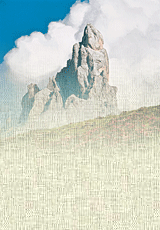
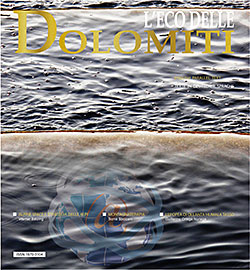

 I think the alarm should be sounding more for us than for the Dolomites. We only seem to want new, impressive installations. "Cubature": that's the magic word. We forget the example of beautiful design provided by the oldest settlements. I'm thinking of those lovely, typical Ladin houses, of the mushroom-shaped houses in Val Badia and their 500-year-old barns: real examples of practical, traditional design. But what I'm really afraid of is the "senfterization" of South Tyrol (Senfter is the famous smoked ham producer, and financed the new ski carousel at Sesto). We are in danger of losing our history and turning into a parody of ourselves. Do you know the big casinos in Las Vegas? Well, there we are. We are at risk of becoming like "The Venice", the casino famous for being a copy of Venice. But it makes sense there; creating a little Venice in the middle of the desert. But here we have a real existence, with real history and traditions; we can't just become a tourist parody of ourselves! We have gone into decline. How much ugliness there is and how much insensitivity! How much light and noise pollution! The Dolomites shouldn't be on airline routes either: the white exhaust trails from the planes reduce the power of the sun-light. We are producing a sort of porno-Alpine tourism, with monstrous hotels on the one hand, and frightening kitsch design on the other. We just go on building in South Tyrol, not because there are sane reasons for developing, but in order to pay less tax and obtain grants. There should be subsidies for good ideas, not cubic metres of cement.
I think the alarm should be sounding more for us than for the Dolomites. We only seem to want new, impressive installations. "Cubature": that's the magic word. We forget the example of beautiful design provided by the oldest settlements. I'm thinking of those lovely, typical Ladin houses, of the mushroom-shaped houses in Val Badia and their 500-year-old barns: real examples of practical, traditional design. But what I'm really afraid of is the "senfterization" of South Tyrol (Senfter is the famous smoked ham producer, and financed the new ski carousel at Sesto). We are in danger of losing our history and turning into a parody of ourselves. Do you know the big casinos in Las Vegas? Well, there we are. We are at risk of becoming like "The Venice", the casino famous for being a copy of Venice. But it makes sense there; creating a little Venice in the middle of the desert. But here we have a real existence, with real history and traditions; we can't just become a tourist parody of ourselves! We have gone into decline. How much ugliness there is and how much insensitivity! How much light and noise pollution! The Dolomites shouldn't be on airline routes either: the white exhaust trails from the planes reduce the power of the sun-light. We are producing a sort of porno-Alpine tourism, with monstrous hotels on the one hand, and frightening kitsch design on the other. We just go on building in South Tyrol, not because there are sane reasons for developing, but in order to pay less tax and obtain grants. There should be subsidies for good ideas, not cubic metres of cement.  The areas with the highest number of tourists, for sure. When the ratio of visitors to residents is totally out of balance, the important social and cultural structures start to disappear. Children grow up with values very different to those of their origins. It is only by recognizing the authenticity of these places, and of our culture and language, that we will manage to discover and perpetuate a proper balance with our surroundings. However, even the most unspoilt areas are in danger. These places may plunge in with even more passion during the "cubature" process, or else they will experience a period of de-ruralisation: the villages in the valley bottom will grow in size, the marginal land will be abandoned, the traditional activities will cease, and life-styles will become standardized.
The areas with the highest number of tourists, for sure. When the ratio of visitors to residents is totally out of balance, the important social and cultural structures start to disappear. Children grow up with values very different to those of their origins. It is only by recognizing the authenticity of these places, and of our culture and language, that we will manage to discover and perpetuate a proper balance with our surroundings. However, even the most unspoilt areas are in danger. These places may plunge in with even more passion during the "cubature" process, or else they will experience a period of de-ruralisation: the villages in the valley bottom will grow in size, the marginal land will be abandoned, the traditional activities will cease, and life-styles will become standardized.  The new ski-lifts will cost between 25 and 30 million Euros, and will involve cutting down 25 hectares of spruce pine and larch forest. I ask myself nowadays if we live in the South Tyrol of the Dolomites or of the ski-lifts. I really wonder whether people come here to enjoy the landscape, or to see the girders, cables and cableways, and the huge canary-yellow pipes in among the crocuses. The company promoting this project is the Sesto Dolomites organization, headed by Franz Sentfer, one of the best-known businessmen in Alto Adige. By means of this operation, the hoteliers hope to get more customers, and the farmers will be paid five times the going market price for their land. To see the farmer uprooted from his land for money: this makes me very unhappy. It is an attack on our land, on our basic culture, because the farmer is a vital player in the South Tyrol local order. It is no accident that one of the most important figures in our culture is the "Saltner" (vineyard- keeper), protector of the land and those who work it. What will we be able to offer our guests in the future? Frozen vegetables and packaged ham? We haven't mentioned the recent agreement drawn up in Milan between Luis Durnwalder, President of the Autonomous Province of Bolzano, and Minister Calderoli, which obliges the Province of Bolzano to pay 40 million Euros a year to its neighbouring provinces. As a result of this, Mr. Durnwalder will be able to make a nice contribution to his friend Mr. Senfter, enabling him to carry out his tourist projects in the Upper Comelico region.
The new ski-lifts will cost between 25 and 30 million Euros, and will involve cutting down 25 hectares of spruce pine and larch forest. I ask myself nowadays if we live in the South Tyrol of the Dolomites or of the ski-lifts. I really wonder whether people come here to enjoy the landscape, or to see the girders, cables and cableways, and the huge canary-yellow pipes in among the crocuses. The company promoting this project is the Sesto Dolomites organization, headed by Franz Sentfer, one of the best-known businessmen in Alto Adige. By means of this operation, the hoteliers hope to get more customers, and the farmers will be paid five times the going market price for their land. To see the farmer uprooted from his land for money: this makes me very unhappy. It is an attack on our land, on our basic culture, because the farmer is a vital player in the South Tyrol local order. It is no accident that one of the most important figures in our culture is the "Saltner" (vineyard- keeper), protector of the land and those who work it. What will we be able to offer our guests in the future? Frozen vegetables and packaged ham? We haven't mentioned the recent agreement drawn up in Milan between Luis Durnwalder, President of the Autonomous Province of Bolzano, and Minister Calderoli, which obliges the Province of Bolzano to pay 40 million Euros a year to its neighbouring provinces. As a result of this, Mr. Durnwalder will be able to make a nice contribution to his friend Mr. Senfter, enabling him to carry out his tourist projects in the Upper Comelico region.  Oh I don't know! Perhaps we should go and look around Switzerland a bit! This isn't the first time I've cited Switzerland as an example, but it's our neighbour, and they also speak Ladino in some parts, which makes me feel well disposed towards them. They really discourage the use of cars: in fact there are some villages and areas you can't even get to by car - I'm thinking of delightful places like Mürren or Saas Fee. Consider how easy it is for tourists to travel by train or public transport. But to get back to us: although I have every respect for motorcyclists, I'd prefer us to be regarded as a paradise for cyclists, rather than for motorcyclists. Ask the Alpine guides why they don't go climbing on the Sella towers any more: they can't make themselves understood with their clients because of the noise from the motordrome a few hundred metres below. We can provide a splendid example with the Dolomites Marathon, involving the participation of 9,000 cyclists out of 28,000 requests for entry! Let's make the roads over our passes a paradise for cyclists and everyone will benefit: both the managers of the refuge huts and the environment!
Oh I don't know! Perhaps we should go and look around Switzerland a bit! This isn't the first time I've cited Switzerland as an example, but it's our neighbour, and they also speak Ladino in some parts, which makes me feel well disposed towards them. They really discourage the use of cars: in fact there are some villages and areas you can't even get to by car - I'm thinking of delightful places like Mürren or Saas Fee. Consider how easy it is for tourists to travel by train or public transport. But to get back to us: although I have every respect for motorcyclists, I'd prefer us to be regarded as a paradise for cyclists, rather than for motorcyclists. Ask the Alpine guides why they don't go climbing on the Sella towers any more: they can't make themselves understood with their clients because of the noise from the motordrome a few hundred metres below. We can provide a splendid example with the Dolomites Marathon, involving the participation of 9,000 cyclists out of 28,000 requests for entry! Let's make the roads over our passes a paradise for cyclists and everyone will benefit: both the managers of the refuge huts and the environment!  Again on the theme of culture, I do not agree with the reasoning used by Messner to justify the new constructions. He uses a historical and cultural premise as a logical basis for his argument. It amounts to this: those areas and high plateaus where we have proof that man once lived, and in general those places that might have been inhabited in the past (up to the rock line, in practice), can justifiably be inhabited by man today, because this is just a continuation of a historic tradition. But we are forgetting to mention one thing: man's impact on the environment was infinitely less great in the past. In mediaeval times, or even in the 1800s, the people who inhabited this area did not live in concrete structures, with spas and golf courses. Maybe we'll be discovering next that Otzi the Ice Man played golf and drove a Cayenne…
Again on the theme of culture, I do not agree with the reasoning used by Messner to justify the new constructions. He uses a historical and cultural premise as a logical basis for his argument. It amounts to this: those areas and high plateaus where we have proof that man once lived, and in general those places that might have been inhabited in the past (up to the rock line, in practice), can justifiably be inhabited by man today, because this is just a continuation of a historic tradition. But we are forgetting to mention one thing: man's impact on the environment was infinitely less great in the past. In mediaeval times, or even in the 1800s, the people who inhabited this area did not live in concrete structures, with spas and golf courses. Maybe we'll be discovering next that Otzi the Ice Man played golf and drove a Cayenne… I am not openly hostile towards Durnwalder, and I recognize his good qualities. That being said, in all the European democracies, there are no periods of tenure which last as long as that of Landeshauptmann (Head of Government). Maybe in Italy there are cycles which last for twenty years, but this is not the case in Germany, Austria, Britain, France and the Scandinavian countries. As to environmental policy...In answer to your question, the first thing I would do would be to resign. Before that, however, I would ask some honest men to rewrite our dreadful town planning legislation.
I am not openly hostile towards Durnwalder, and I recognize his good qualities. That being said, in all the European democracies, there are no periods of tenure which last as long as that of Landeshauptmann (Head of Government). Maybe in Italy there are cycles which last for twenty years, but this is not the case in Germany, Austria, Britain, France and the Scandinavian countries. As to environmental policy...In answer to your question, the first thing I would do would be to resign. Before that, however, I would ask some honest men to rewrite our dreadful town planning legislation.